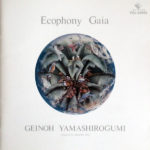
Deep, deep, earth music from Tsutomu Ōhashi and the Geinoh Yamashirogumi crew. A macrosymphony composed for the International Garden and Greenery Exposition in Osaka, Japan, 1990, Ecophony Gaia, was supposed to be the stunning, aural centerpiece for a light and water performance system echoing the sentiment of the venue: “Harmonious Coexistence of Nature and Mankind.”
Ecophony Gaia was in its truest essence the final part of a trilogy that began with 1986’s Ecophony Rinne, continued, in 1988, with their most-known work the soundtrack to Katsuhiro Otomo’s dystopian, cyber-punk film Akira (released as Symphonic Suite Akira), and this release mere months later. Looking back one can break up these releases into a holy musical trinity: Ecophony Rinne = spirit, Symphonic Suite Akira = body, and Ecophony Gaia = Gaia/earth. Perhaps that’s why, at least for me, this release still holds my highest fascination. It’s the release that looks to the highest source for inspiration.
You see, Geinoh Yamashirogumi was unlike any band out there. A collective, made up of mostly of people who come from the everyday world – teachers, lawyers, doctors – led by the visionary leadership of composer Dr. Tsutomu Ōhashi began in the mid ’70s as a way to introduce Japanese audiences to world music outside their shores. So, pervasive was western culture that they realized that other cultures were being ignored by the Japanese music community. Geinoh Yamashirogumi took it upon themselves to discover and reinterpret everything from Bulgarian chants, Balinese gamelan music, African Yoruba drumming, and more from untold “other” rarely known traditions. Disdaining much, of any, electronics, their early back-to-basics releases found fans in the Prog and world music world.
Eventually, things had to change. Tsutomu Ōhashi signalled a shift in Ecophony Rinne. Always intrigued by synthesizers and computer systems, Tsutomu never ventured very deep into the electronic world because of a certain lack of flexibility. The music of the non-Western world, had an ability to work in microtonal pitches. Hitting notes that weren’t as rigid as classical Western intonation allowed them the flexibility to combine gamelan with textural chant, for example. In the mid ’80s, finally, technology advanced enough to allow them to discover synthesizers that could afford them the ability to create microtunings that would allow them to blend the “new” with those who made time immemorial. It’s not something anyone taught them, but as non-classically trained musicians, they were able to learn by modifying those synthesizers and finding them place in their world.
Flowing through recurring themes of Birth, Death, and Rebirth that would continue in the following two parts of the trilogy, Ecophony Rinne was as spiritual Geinoh Yamashirogumi would get. Like a newborn child discovering the world – the sound of “Primordial Germination” to begin with – so traversed the otherworldly music of Ecophony Rinne. No longer world music, Geinoh Yamashirogumi were approaching something magical, beyond any known musics.
Conceived and recorded before the film Akira came out, Symphonic Suite AKIRA was deeply human music from Geinoh Yamashirogumi. Using percussion as a powerful tool to pluck out the beauty and sense in this chaotic space we call humanity, Tsutomu Ōhashi originally composed this music as sonic modules that would allow Akira director Katsuhiro Otomo to arrange the film as he saw fit. For two hours, the entirety of the film’s run-length, Katsuhiro used the stunning mix of heavy, mutating percussion, floating synthesizer, Japanese chants, to treat us to a world where our dream world is one distinctly of our creation. Technology, death, and power, all mingling to mold where we create our own experimental environment. A landmark film, Akira uses Geinoh Yamashirogumi’s soundtrack to subversively dig at very human things we lose as technology becomes more rampant and our reliance on it grows even more pervasive – cyberpunk is something Akira is not.
This brings me to Ecophony Gaia, Geinoh Yamashirogumi most hopeful release. Rebirth, the hardest thing to capture in music, is something Ecophony Gaia expounds upon through sonics and feeling. You hear this in light echoes from Symphonic Suite AKIRA coursing through Ecophony Gaia, acting as symbols saying: “not everything from the past needs to be discarded, that certain things, when rethought of, hold a heavier power.” The Japanese Noh music you heard trapezing through Akira’s “Illusion” walks positively untethered in Ecophony Gaia’s “Euphony”, Indonesian gong chimes that hit darkly in Akira’s “Tetsuo” transform Ecophony Gaia’s “Catastrophe” into the light sublime, serene music that it is.
What’s left over are the songs that point to new directions. Those that derive their influence from things that aren’t easily quantifiable. The introduction of field recordings to a warmer palette of sound makes Ecophony Gaia Geinoh Yamashirogumi’s first roots album. Of course, these roots belong to worldlier kind of music. Rhythms that sound like water coursing downstream from brook to ocean, electronic layers that hum and cycle through, string instruments that hover like atmosphere, wind instruments that sound like air and breath, and the powerful sound of human voices presenting divinity through communal chant – those all constitute the ecosystem of Ecophony Gaia. Things that you’ve heard/felt before, renewed in a different lustre.
When you hear the album, notice how there are two sides to its whole: “Chaos” ending in “Euphony”, “Catastrophe” ending in “Gaia”. It would be a disservice to describe the way it sounds, it’s an album based on belief not premonition. All you’ll find in Ecophony Gaia are movements. Hopeful movements. Needed movement.
